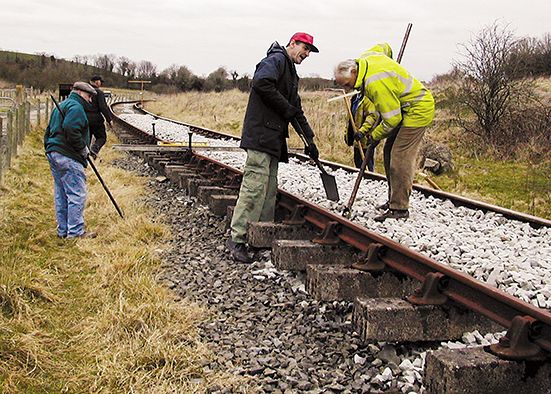Remarkable achievement to drive railway forward
Remarkable achievement to drive railway forward
18 September 2024

IT’S 20 years since the Downpatrick and Co Down Railway opened its extension to Inch Abbey.
To mark the occasion, the railway has published a special anniversary edition of its popular electronic bulletin.
Despite last November’s devastating flood in Downpatrick which engulfed the heritage railway, officials were determined not to forget the anniversary.
For many who joined the railway in recent years, including current marketing director Niall Kelly, it is difficult to fathom the idea of the railway without Inch Abbey.
Yet, he said that without the persistence of long-term members, that would be very much the case.
While unfortunately under current circumstances the railway has been unable to mark the occasion with a special train – although there is some light at the end of this particular tunnel – Mr Kelly hopes the special e-edition goes some way towards celebrating the occasion with a
reflection of the past two decades and indeed, the effort that went to its opening before that.
“Testament to the tenacious spirit of our volunteers, the Inch Abbey extension was a remarkable achievement for an organisation of our size and is an inspiration to those all helping to drive the railway forward,” he said.
“And with that determination, think of what we could be celebrating in another 20 years.
Other contributors to the special bulletin include founder member Gerry Cochrane, George Walker, Norman Bodel and current chairman Robert Gardiner.
Mr Cochrane said his initial idea of a restored Downpatrick Steam Railway in 1982 was intended to run from Downpatrick to Ardglass.
But he explains in the anniversary bulletin that as time progressed and the plans became public, it resulted in local farmers, through whose property the railway may have impinged, raising loud objections.
“This initial idea had therefore to be abandoned and a change of plan considered,” Mr Cochrane explains.
“Our existing journey at that time was a distance of a half mile of track running from Downpatrick station out to the Loop platform. We needed to extend our track further and as I was a member of the Board at that time, various ideas were tossed among us collectively as to what would be the best solution.
“I had always considered Inch Abbey to be an attractive destination and brought this idea up for discussion at one of our board meetings.”
Mr Cochrane said the result of this was that he was asked to make the necessary investigations and see what possibilities were available.
“The first requirement was getting the land, so a visit was made by me to Lord Dunleath’s land agent, Mr Hugh Press, asking for permission for this to take place,” he continued.
Hurdle
“Lord Dunleath raised no objection so the next hurdle was that a bridge, under my supervision, would have to be constructed over the Quoile
River. Approval also had to be sought from the land owner of that section and to our relief, we found him to be most co-operative, so it was all systems go.”
A new platform at Inch Abbey also had to be constructed but with very few funds in the bank account, officials had to keep costs to a minimum.
Mr Cochrane said the Inch Abbey extension was built on a council land-filled site and he expected a certain degree of settlement to take place during the intervening years.
“Therefore, the design had to allow the structure to be as light as possible,” he continued.
“This was an exciting time for the railway and has proved to be a great success. It gave extra length to our train rides which was more satisfactory for our passengers and it meant that those taking the train to Inch Abbey experienced a different view of Downpatrick, especially when crossing over the Quoile River.”
Looking back 20 years to when the extension to Inch Abbey was opened, Mr Gardiner said it felt “both like yesterday and an age ago.”
He explained when he joined the heritage railway in 1997, he didn’t fully grasp how expansive that time would be.
“We were already laying track past Magnus’s Stop, with sleepers also set out all the way to the River Quoile. It truly felt like we were doing something unprecedented in Northern Ireland –reopening a closed railway and yes I know Great Victoria Street reopened in 1995, but still.
“The extension to Inch Abbey came about thanks to a regeneration committee formed by Down Council around 1992. I remember my predecessor, Mike Collins, telling me that the fledgling Downpatrick and Ardglass Railway as it was then known, had no intention of trying to cross the Quoile—it was simply too big a project.”
Mr Gardiner said crossing the Ballydugan Road didn’t seem quite so intimidating.
“When the regeneration committee asked if we would be interested in extending beyond the Quoile and offered to secure funding for the project, the board practically bit their hand off.
“Unlike the extension to Ballydugan, we were very fortunate to have the support of John Kennedy on the north bank of the Quoile, as well as the Inch Abbey parish,” continued Mr Gardiner.
“These key alliances were essential to getting the extension off the ground and passenger numbers soared after the line was extended to Inch.
“No longer was it just a short train ride to the Loop and Magnus’s Stop. Now we had a proper destination and the journey was double the length. It was transformative.”
Mr Gardiner said he didn’t think anyone fully appreciated how urgent it was to get the Inch Abbey line open by 2004.
“A project of this scale took much longer than most grand bodies usually allow, and time was genuinely against us. I had only joined the Board the year before and vividly recall the near-panic in the lead-up.
“When the line finally opened, I think we felt more relief than celebration and I’ve just realised we never officially launched it. Maybe we could still have a belated celebration.”
Mr Gardiner added: “Twenty years is a long time and while the facilities at Inch have certainly improved, the platform is starting to show its age.
“Looking ahead, we are exploring options for a more durable, rot-proof system and, hopefully, we can even install lighting so that Inch can be used all year round.”


